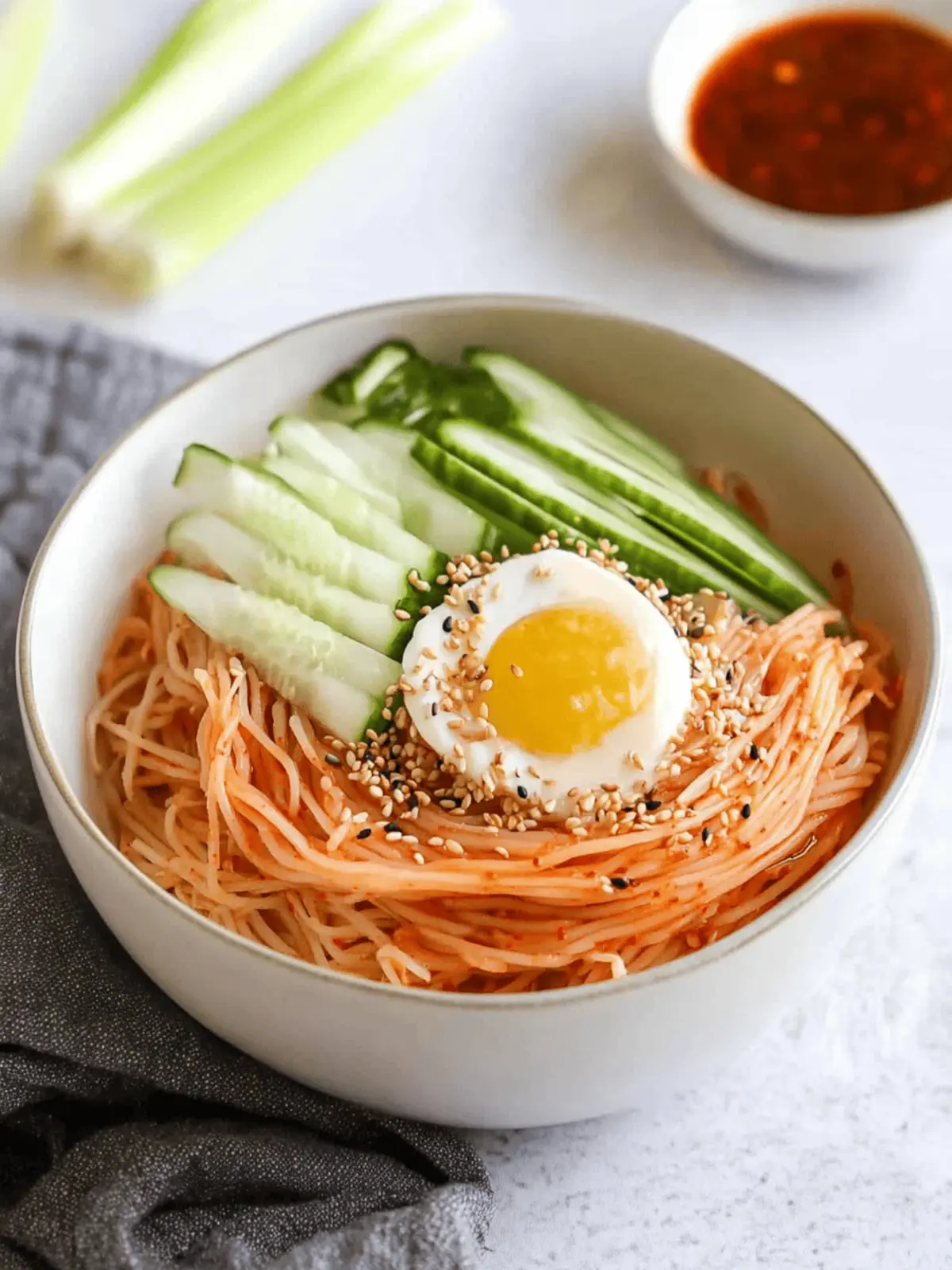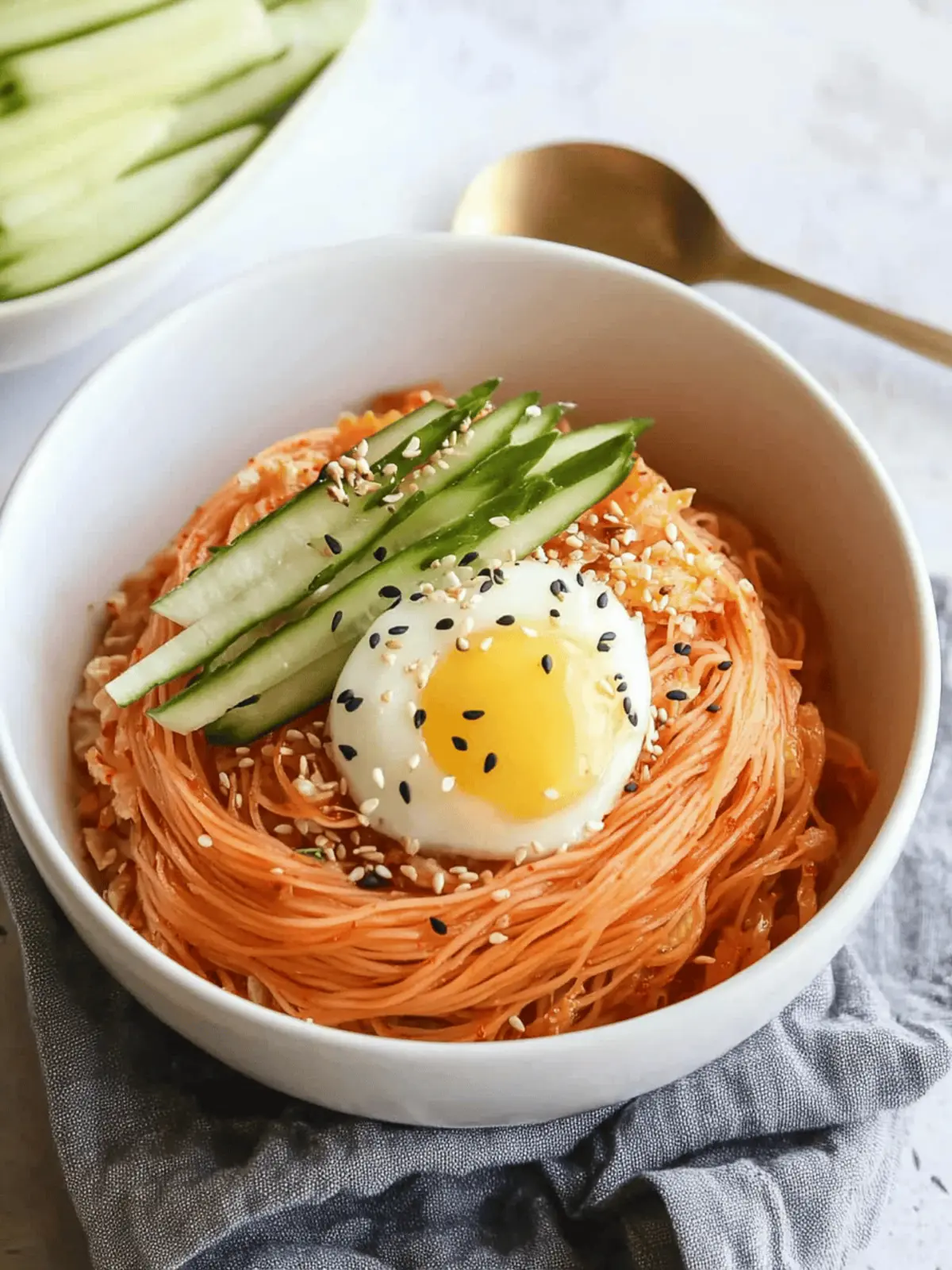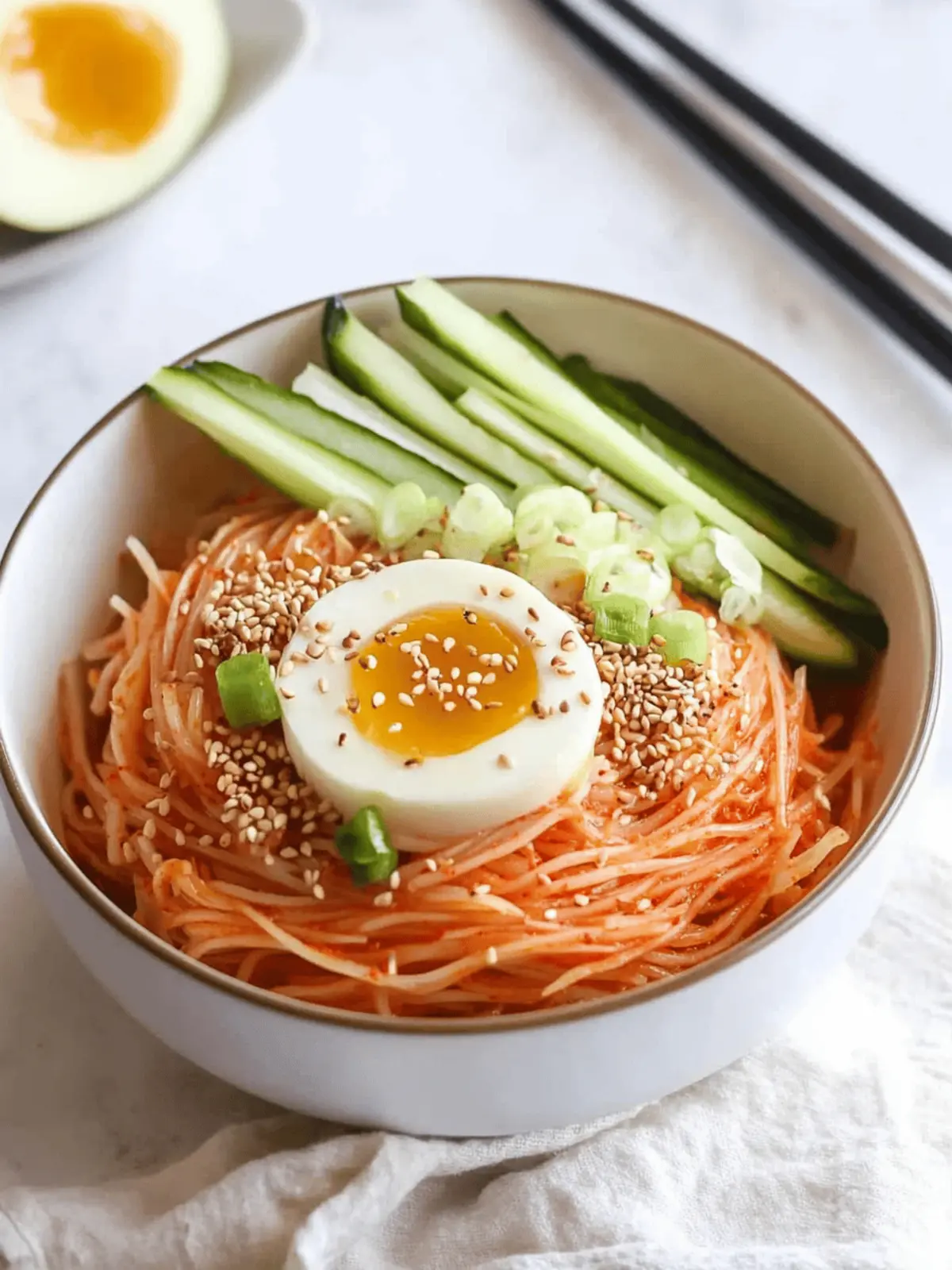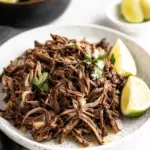There’s something truly exhilarating about diving into a bowl of vibrant flavors that dance on your palate, and my journey into the world of Korean Kimchi Bibim Guksu began with just that. After a particularly hectic week, the thought of preparing something fresh and lively seemed like the perfect antidote. A quick glance at my pantry revealed the essentials for this mouthwatering dish, loaded with colorful veggies and zesty sauces that promised to uplift my spirits.
Imagine the satisfying crunch of cucumber complemented by the tangy, fermented kick of kimchi and the delightful chewiness of extra-thin noodles. This versatile dish is perfect for when you crave a quick meal that doesn’t skimp on flavor or flair. Best of all, it comes together in under 10 minutes, making it an ideal choice for busy evenings or spontaneous gatherings. Join me as I guide you through crafting this delicious, fuss-free recipe that’s sure to impress your taste buds—and anyone lucky enough to share it with you!
Why is Korean Kimchi Bibim Guksu amazing?
Speedy Preparation: This dish is ready in just 10 minutes, making it a go-to for busy weeknights.
Bursting with Flavor: The combination of tangy kimchi, savory soy sauce, and spicy gochujang creates an unforgettable taste experience.
Fresh Ingredients: With crisp cucumber and a perfectly cooked egg on top, every bowl is a vibrant feast.
Versatile Enjoyment: Serve it warm or chilled, making it perfect for any season or occasion. For more inspiration, check out our guide on quick noodle recipes.
Impressive Presentation: The colorful layers make this dish as visually appealing as it is delicious, sure to impress family and friends.
Korean Kimchi Bibim Guksu Ingredients
• Let’s gather the essentials for a vibrant bowl of deliciousness!
For the Noodles
- Korean wheat noodles (Somyeon) – 3.52 oz of extra-thin round noodles that provide that delightful chewy texture.
For the Veggies
- Cucumber – ¼ cup sliced into matchsticks for a refreshing crunch.
For the Protein
- Egg – Cooked to perfection, this adds a rich creaminess to your dish.
For the Kimchi
- Kimchi – ¼ cup of well-fermented kimchi brings tangy depth and spice to the mix.
For the Sauce
- Soy sauce – 2 tablespoons give a savory kick; feel free to use low-sodium for a lighter option.
- Sesame oil – 1 tablespoon adds a nutty richness that ties all the flavors together.
- Rice vinegar – 1 tablespoon provides a subtle tang that balances the dish beautifully.
- Gochujang – 1 tablespoon for an essential spicy kick; it’s the secret to making Korean Kimchi Bibim Guksu truly memorable!
- Granulated sugar or honey – 1 tablespoon to balance the heat; honey works well for a touch of natural sweetness.
- Garlic – 1 clove minced for an aromatic boost that enhances all the flavors.
- Sesame seeds – ½ teaspoon to sprinkle on top, adding both texture and a lovely nutty flavor.
Each ingredient plays its part in making this quick and delightful dish a hit at your dining table!
How to Make Korean Kimchi Bibim Guksu
-
Prepare the sauce: In a mixing bowl, chop your kimchi into smaller pieces using clean kitchen scissors. Add in the soy sauce, sesame oil, rice vinegar, gochujang, sugar, and minced garlic. Mix everything together until well combined.
-
Cook the egg: Bring a small pot of water to a boil. Carefully lower the egg into the boiling water and cook for 7 minutes over high heat. For a hardboiled egg, boil for an additional 3 minutes. Afterward, transfer the cooked egg into an ice bath to cool. Once cooled, peel and slice it in half, then set aside.
-
Boil the noodles: In a medium-large pot, fill it halfway with water and bring it to a boil. Gently add the somyeon noodles and cook for 2-3 minutes, or until they become chewy. Strain the noodles and rinse them under cold water until thoroughly cooled. Give them a gentle shake to remove any excess water.
-
Mix it all together: Add the strained noodles to your prepared sauce and mix well using clean hands. Carefully transfer the mixture to a serving bowl. Top with matchstick cucumbers and the halved egg. Enjoy your deliciously vibrant dish!
Optional: Garnish with additional sesame seeds for an extra crunch.
Exact quantities are listed in the recipe card below.
How to Store and Freeze Korean Kimchi Bibim Guksu
Fridge: After preparing, you can store leftover Korean Kimchi Bibim Guksu in an airtight container for up to 3 days. Keep it chilled to maintain freshness.
Freezer: While not ideal for freezing, you can freeze the noodles and sauce separately for up to a month. Thaw them in the fridge overnight before enjoying.
Reheating: When ready to eat, simply reheat the noodles in boiling water for a quick refresh or enjoy cold with toppings. Add fresh cucumbers or an extra egg for a delightful touch!
Make Ahead Options
Korean Kimchi Bibim Guksu is perfect for meal prep! You can prepare the sauce (kimchi, soy sauce, sesame oil, rice vinegar, gochujang, sugar, and garlic) up to 3 days in advance and refrigerate it in an airtight container. The noodles can also be cooked and stored in the fridge for up to 24 hours; just rinse them in cold water to prevent sticking, and toss them with a bit of oil. When you’re ready to serve, simply mix everything together, top with freshly sliced cucumbers and a cooked egg, and enjoy a delicious meal with minimal effort. This way, you’ll have a vibrant dish that tastes just as fresh as when made from scratch!
Tips for the Best Korean Kimchi Bibim Guksu
-
Noodle Consistency: Ensure your somyeon noodles are cooked just until chewy; overcooking can lead to a mushy texture.
-
Kimchi Quality: Use well-fermented kimchi for a robust flavor. Fresh kimchi may lack the tanginess that enhances this dish.
-
Sauce Balance: Adjust sugar according to your taste. If the gochujang is too spicy, you can add a bit more sugar to balance the heat.
-
Chill the Noodles: Rinsing the noodles under cold water is essential; it not only cools them but also helps prevent sticking.
-
Egg Cooking Time: For a perfectly soft-boiled egg, stick to 7 minutes. A hard-boiled egg will elevate the dish, but adjust your cook time based on preference.
Korean Kimchi Bibim Guksu Variations
Feel free to play around with this dish, adding your own personal touch that delights your palate!
-
Vegetarian: Skip the egg or opt for tofu, lightly fried or grilled for added protein and texture.
-
Spicy Twist: Increase the gochujang to 2 tablespoons for a fiery flavor explosion that spice lovers will adore!
-
Crunchy Additions: Toss in radish or bell pepper strips for extra color and a delightful crunch that brightens each bite.
-
Noodle Swap: Use rice noodles or zucchini noodles for a gluten-free or low-carb option that still satisfies.
-
Coconut Creamy: Add a tablespoon of coconut milk to the sauce for a subtly sweet twist that enhances the dish’s richness.
-
Herb Garnish: Fresh cilantro or green onions scattered on top add freshness and vibrancy, elevating the dish’s flavor profile.
-
Sweet & Spicy: Try adding a touch of sriracha along with the gochujang to create a lovely balance of heat and sweetness.
-
Nutty Flavor: Incorporate crushed peanuts or cashews on top for a crunchy contrast that complements the other textures beautifully.
What to Serve with Korean Kimchi Bibim Guksu?
Dive into a playful and vibrant meal that pairs beautifully with sensorial delights!
-
Spicy Korean Fried Chicken: The crunchy, tender bites of fried chicken deliver a satisfying contrast to the fresh, crunchy noodles while enhancing the overall spicy experience.
-
Garlic Edamame: Steamed edamame sprinkled with garlic salt adds a delightful pop of flavor and a healthy snack, perfect for sharing.
-
Crispy Tempura Vegetables: Lightly battered and crisped veggies bring a fun texture to the meal, their subtle sweetness beautifully balancing the spiciness of the bibim guksu.
-
Pickled Radish: These tangy slices brighten up each bite and enhance the umami flavors, making them a quintessential Korean side dish.
-
Korean Tofu Stew (Sundubu-jjigae): The creamy and spicy broth complements the texture of the noodles, creating a hearty pairing that will warm your heart.
-
Asian Cucumber Salad: The refreshing crunch from this salad echoes the cucumbers in your bibim guksu, creating joyful layers of crispness in every bite.
-
Green Tea: A chilled or hot brew serves as a refreshing drink, highlighting the dish’s vibrant flavors while promoting a sense of calm.
-
Mango Sticky Rice: For dessert, this sweet dish balances tangy notes with a touch of creaminess, providing a refreshing finish to an exciting meal.
Korean Kimchi Bibim Guksu Recipe FAQs
What kind of kimchi should I use?
For the best flavor in your Korean Kimchi Bibim Guksu, I recommend using well-fermented kimchi. This type is typically tangy and has a well-developed flavor that really enhances the dish. If using fresh kimchi, it may not have the same depth of flavor, so let it sit for a few days in the fridge before using.
How do I store leftovers?
You can store any leftover Korean Kimchi Bibim Guksu in an airtight container in the fridge for up to 3 days. Make sure to keep it chilled to maintain its freshness. When properly stored, the flavors will continue to meld and create a tasty leftover dish!
Can I freeze Korean Kimchi Bibim Guksu?
While it’s best enjoyed fresh, you can freeze the noodles and sauce separately for up to a month. To do this, cook your noodles and allow them to cool completely before placing them in a freezer-safe bag or container. The sauce can also be frozen in an airtight container. To enjoy later, thaw both in the fridge overnight and reheat the noodles in boiling water.
What should I do if my noodles are too sticky?
If you find your noodles are sticking together, there are a couple of easy fixes! First, make sure to rinse the cooked noodles thoroughly under cold water, as this helps remove the excess starch that can cause sticking. If that doesn’t do the trick, you can try adding a tiny drizzle of sesame oil after rinsing—just enough to coat them lightly, which can help prevent them from clumping together.
Are there any dietary considerations I should know?
Absolutely! If you’re serving Korean Kimchi Bibim Guksu to someone with food allergies, check the ingredients of your kimchi and sauces. Some brands might contain fish or shellfish, which are common allergens. For a vegetarian or vegan option, ensure your kimchi is fish-free and substitute any non-vegan elements with plant-based alternatives, like vegetable sauce or tofu instead of egg.
How do I know if my noodles are perfectly cooked?
You want your somyeon noodles to be chewy but not overly soft. After cooking them for 2-3 minutes, take a taste to see if they have the right texture. If they feel too firm, give them another minute, but be careful not to overcook. The perfect noodle should be soft yet still have a pleasant bite!
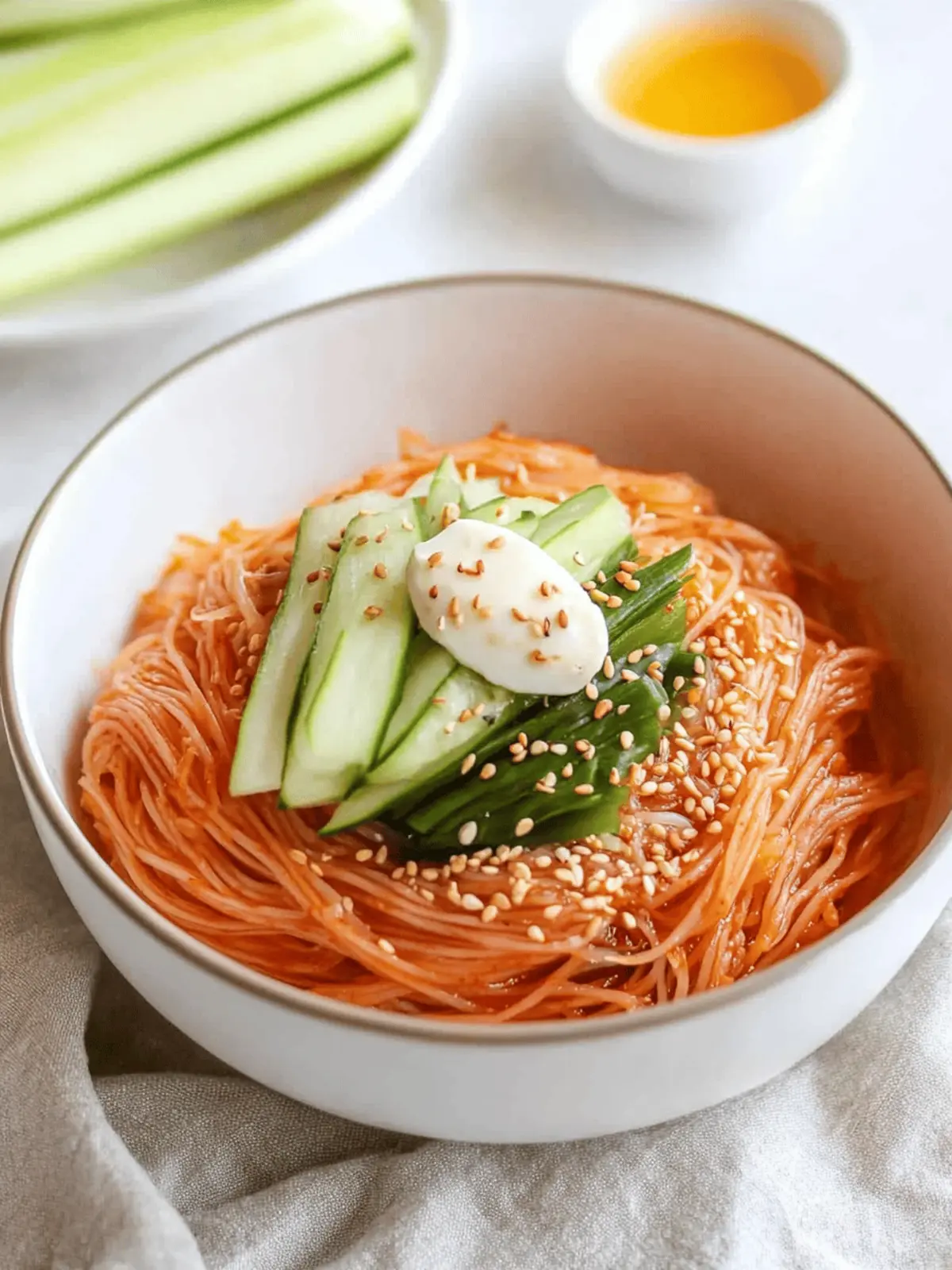
Delicious Korean Kimchi Bibim Guksu in Just 10 Minutes
Ingredients
Equipment
Method
- In a mixing bowl, chop your kimchi into smaller pieces using clean kitchen scissors. Add in the soy sauce, sesame oil, rice vinegar, gochujang, sugar, and minced garlic. Mix everything together until well combined.
- Bring a small pot of water to a boil. Carefully lower the egg into the boiling water and cook for 7 minutes over high heat. For a hardboiled egg, boil for an additional 3 minutes. Afterward, transfer the cooked egg into an ice bath to cool. Once cooled, peel and slice it in half, then set aside.
- In a medium-large pot, fill it halfway with water and bring it to a boil. Gently add the somyeon noodles and cook for 2-3 minutes, or until they become chewy. Strain the noodles and rinse them under cold water until thoroughly cooled. Give them a gentle shake to remove any excess water.
- Add the strained noodles to your prepared sauce and mix well using clean hands. Carefully transfer the mixture to a serving bowl. Top with matchstick cucumbers and the halved egg. Enjoy your deliciously vibrant dish!

